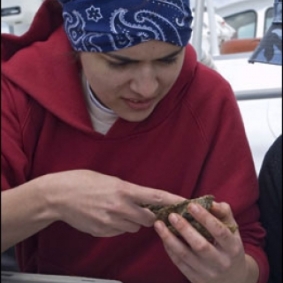Eight students will be presenting the summer work at the Ocean Sciences Meeting in March 2022!
Madeline Wedge, LaSalle University
Class Year:
2008Mentor:
David Secor Ph.D.Project Title:
A Preliminary Assessment of Trophic Ecology of Three Abundant Meso-Predator Elasmobranchs from a Shallow Middle Atlantic Bight Habitat
Abstract:
This study examined trophic niche aspects of three meso-predatory elasmobranchs abundant within the shallow neritic waters of coastal Maryland: smooth dogfish (Mustelus canis), clearnose skate (Raja eglanteria) and bullnose ray (Myliobatis freminvillei). Graphical analysis assessed major prey items and foraging strategy, while dietary overlap measurements determined possible competitive interactions. Lastly, trophic level for each species was estimated using proportions of differing prey categories within the diet. Smooth dogfish and clearnose skate gut content biomass were dominated by small fish and crabs (Anomura and Brachyura). Gut contents indicated a generalist foraging strategy for smooth dogfish and clearnose skate. Conversely, bullnose ray gut contents indicated a diet almost exclusively composed of mollusks, specifically gastropods, suggesting that the bullnose ray is a specialized molluscivore. Estimates of trophic level indicate clearnose skate occupied the highest trophic level (3.97), bullnose ray the lowest (3.67), and smooth dogfish were intermediate (3.71). Finally, significant dietary overlap was only evident between smooth dogfish and clearnose skate. This significant overlap indicates similar ecological niches for the smooth dogfish and clearnose skate; however, competition for food sources may not greatly affect the abundance of the two species given their generalist feeding patterns. The results suggest a minimal potential interaction with large teleost species, specifically with competition for food sources or predation of juvenile fish. Thus changes in abundance in these elasmobranch species may not affect commercially important teleost species.
Location:
Chesapeake Biological LaboratoryPublications:
Woodland, R., D. Secor, and M. Wedge*. 2011. Trophic resource overlap between small elasmobranchs and sympatric teleosts in Mid-Atlantic Bight nearshore habitats . Estuaries and Coasts 34:391-404 .





